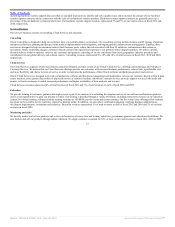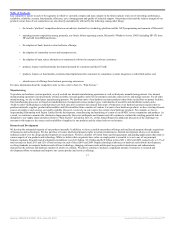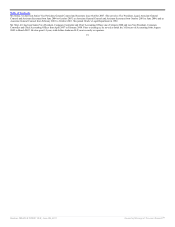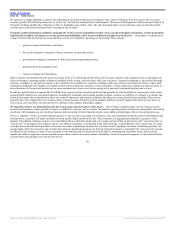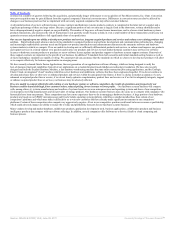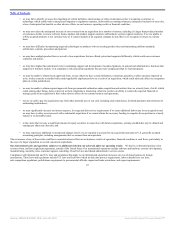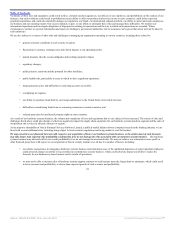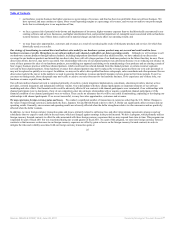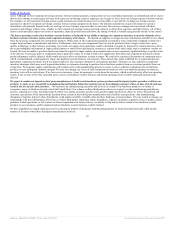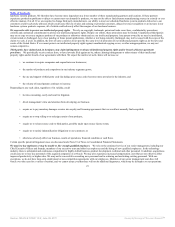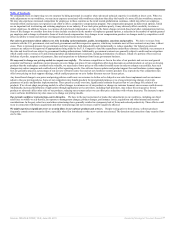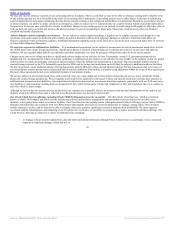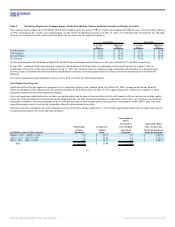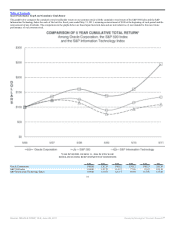Oracle 2010 Annual Report Download - page 28
Download and view the complete annual report
Please find page 28 of the 2010 Oracle annual report below. You can navigate through the pages in the report by either clicking on the pages listed below, or by using the keyword search tool below to find specific information within the annual report.
Table of Contents
Violations of these laws and regulations could result in fines, criminal sanctions against us, our officers or our employees, and prohibitions on the conduct of our
business. Any such violations could result in prohibitions on our ability to offer our products and services in one or more countries, could delay or prevent
potential acquisitions, and could also materially damage our reputation, our brand, our international expansion efforts, our ability to attract and retain employees,
our business and our operating results. Our success depends, in part, on our ability to anticipate these risks and manage these difficulties. We monitor our
international operations and investigate allegations of improprieties relating to transactions and the way in which such transactions are recorded. Where
circumstances warrant, we provide information and report our findings to government authorities, but no assurance can be given that action will not be taken by
such authorities.
We are also subject to a variety of other risks and challenges in managing an organization operating in various countries, including those related to:
• general economic conditions in each country or region;
• fluctuations in currency exchange rates and related impacts to our operating results;
• natural disasters, like the recent earthquake and resulting tsunami in Japan;
• regulatory changes;
• political unrest, terrorism and the potential for other hostilities;
• public health risks, particularly in areas in which we have significant operations;
• longer payment cycles and difficulties in collecting accounts receivable;
• overlapping tax regimes;
• our ability to repatriate funds held by our foreign subsidiaries to the United States at favorable tax rates;
• difficulties in transferring funds from or converting currencies in certain countries; and
• reduced protection for intellectual property rights in some countries.
As a result of our hardware systems business, the volume and complexity of laws and regulations that we are subject to have increased. The variety of risks and
challenges listed above could also disrupt or otherwise negatively impact the supply chain operations for our hardware systems products segment and the sales of
our products and services in affected countries or regions.
As the majority shareholder of Oracle Financial Services Software Limited, a publicly traded Indian software company focused on the banking industry, we are
faced with several additional risks, including being subject to local securities regulations and being unable to exert full control.
We may not achieve our financial forecasts with respect to our acquisition of Sun or our hardware systems business, or the achievement of such forecasts
may take longer than expected. Our profitability could decline if we do not manage the risks associated with our hardware systems business. Our hardware
systems business may adversely affect our overall profitability if we do not manage the associated risks. We may not achieve our estimated revenue, profit or
other financial projections with respect to our acquisition of Sun in a timely manner or at all due to a number of factors, including:
• our relative inexperience in managing a hardware systems business and related processes or the unplanned departures of some important employees
could adversely impact our ability to successfully run our hardware systems business, which could adversely impact our ability to realize the
forecasts for our hardware systems business and its results of operations;
• we may not be able to increase sales of hardware systems support contracts or such increase may take longer than we anticipate, which could result
in lower revenues and profitability, or slower than expected growth of such revenues and profitability;
24
Source: ORACLE CORP, 10-K, June 28, 2011 Powered by Morningstar® Document Research℠



